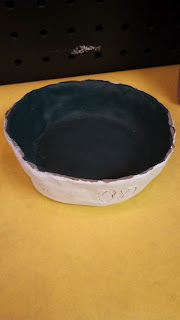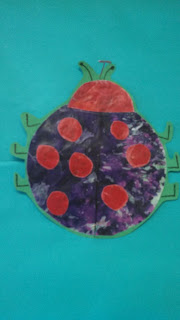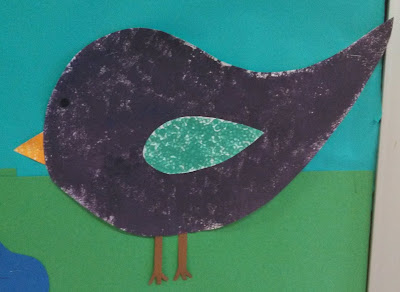Monday, April 29, 2013
Name Painting
This lesson required us to create our name using different mediums. The first step was to take our white piece of construction paper and fold it to create 12 squares. Next, we glued the white paper onto a large piece of construction paper. Then we took a stack of 6 colored construction paper squares. Now it was time to create a pattern. First a colored square then a white then a colored. This repeated until you go the whole sheet covered.
Then we created a pattern by writing our name in oil pastels. I started by making my M orange, then O purple, and R green. I repeated that color pattern with the remaining letters in my name. Now we painted over the letters that were on the white squares. We used water color to paint over it. Because we wrote our names in oil pastels, the water color resisted the oil pastel and only went on the paper.
An extension activity would be to have the students create symbols in each square that represent something important to them. It would be a fun way to learn about your students at the beginning of the year like we did with our feet. Another fun way would be to draw a picture that beings with the same letter as the one in your name. For example, I would draw a monkey for M, an orange for O, etc.
Implementing Art History
I think it would be fun to do an art gallery with the students. They could create their own art work from artists who inspired them. The students would learn about the different artists and periods of time they created their pieces in. Then when all the students have created their pieces, you could have an art gallery showing one night when they students display their work and have family and friends come and view their work.
Sunday, April 28, 2013
Gone Fishing With Paper Plate Fish
Another project we did this week was paper plate fish. At the beginning of the lesson, we talked about geometric shapes and patterns. The first step was to create a geometric pattern using 3 different shapes on a piece of scrap paper. One requirement was we had to have a square in our pattern. Then we copied that pattern onto the grid that was made on our fish. Each shape had to be a different color and it had to fill up the entire square. After we drew and colored each shape, we could color the rest of our fish. We could use whatever pattern and colors we wanted to color the rest of our fish.
Once our fish was colored, we cut the mouth out. The piece that we cut out became the fin of our fish. Now we were given our back tail fin. We were allowed to color it however we pleased. The last steps were to glue on an eye and draw gills between the mouth and fin.
An extension activity would be to incorporate this into a science lesson. The students could do an in-depth study of fish. We had to draw fins on our fish, so the students could study about gills and other parts of the fish. They could also learn about where different fish live and their life cycle.
Patchwork Quilt
This week we created cute patchwork quilts. I have to admit, I had a little trouble with the project because I am a perfectionist and I couldn't get all of my squares to line up perfectly. However, it turned out really cute.
First we started out by picking out 8 pieces of 12"x 12" scrap booking paper. The next step was to chose 4 of those papers and cut a 4 inch square out of each of those 4 papers. Those squares were the background pieces of our quilt. Next, we took the circle pattern and cut out a circle from each of the remaining 4 pieces of paper. Now we glued the circles to the middle of each square. Each square had a circle in the middle of it, and we could choose which circle went with each square.
Now that the circles were glued down, we took our smaller 1" square pattern and traced it 4 times on the back of each 4" square. After we traced and cut all of the smaller squares out, we had 16 1" squares. Then we got to chose the arrangement of all of the smaller squares. I just kept switching them around until I found which pattern I liked best. Next, we glued them down leaving a boarder around all of them. When we glued them down, we had the option to glue them all together or separate each of the 4" squares. After we were done gluing, we had to draw a boarder around the edge. I chose to decorate the corners.
An extension activity would be to crate a real class quilt. Each child could decorate a square using fabric markers. The child could draw something that represented them, or use a topic you are learning about. It would be fun to do an abc quilt and each student has to come up with an item that starts with that letter. For example, if the students were studying Lewis and Clark the students could each draw something that starts with the letter that has meaning to the Lewis and Clark adventure. The students would be learning and creating at the same time.
Pinch Pots

Then it was time to smooth out the pot. To do this, you needed a cup of water to dip your hand into. All we had to do was get our hand wet in the cup of water, then start rubbing and smoothing out our pot. You don't have to use a lot of water, just a little worked well. By using the water, it smoothed out all of the finger prints and cracks that were formed when we were pinching the pot.
Next we carved symbols into the clay using small wooden tools that looked like large toothpicks. The symbols had to represent things that are important to us. I did a heart to represent the love for my family and friends, a fish and pole to show my love of fishing, flip flops because I love to wear them and hate socks, a flower because I love to garden and an ice cream cone because that is my favorite food.
Now it was time to paint our pots. It was great that we could paint them when the clay was still wet. We used acrylic paint so it didn't crack, like tempera paint. I mixed blue and yellow and white to make a green color for the inside of my pot. I used white for the outside. I had to make sure I didn't get a lot of paint inside my carvings. After I was done painting, I used the carving tool to get any paint out of the carvings.
An extension activity would be to study cultures that made clay pots for their own use or to sell to others. You could also study cultures that used symbols in their art work or to tell a story. It would be a really fun social studies unit!
Wednesday, April 17, 2013
Springtime Printmaking
This lesson was taught by Molly and Brittany. Their lesson focused on print making. The first step to their lesson was to think of something that dealt with spring. I chose a bird. Then I had to draw the bird on a 12" x 18" piece of construction paper. I drew the parts of my bird separately rather than making it all one picture.
The next step to this project was to pick 3 items that would create different textures on my bird. The items we could choose between were: marshmallows, Q-tips, sponge, cardboard, toy cars, cups and forks, golf balls. I chose to use a sponge for the body, Q-tip for the wing, and cardboard for the beak.
Next we were given acrylic paint. My partner and I chose to mix colors to create colors other than the primary colors we were given. I mixed blue and red to create the purple. I used red and yellow to make orange for the beak. And I mixed blue and yellow to make green then added more blue and white to create the wing color.
Then we dipped our texture items into the paint and covered our drawing. We were supposed to leave some white space to help you see what items you used. I may have used too much paint on mine. Once I was done painting and it dried, I cut and glued my beak, wing, and construction paper legs onto my bird's body.
An extension activity is to incorporate math. You could teach the students about patterns that happen when you create this picture. If you used the car, the tires would have created a pattern.
Melting Into Spring

This was the lesson I peer taught with Teresa Edelman. For our lesson we taught crayon melting. For our anticipatory set, we had the students go on a bug hunt around the classroom. They seemed to have a lot of fun searching for the bugs. We also played a clip from A Bug's Life.
For our lesson, we have the students 2 pieces of folded wax paper, crayons, and a file. We then taught the students how to properly shave the crayons onto the open sheet of wax paper. The students were to shave until one side of the wax paper was completely covered. They then walked slowly walked to the back of the room where Teresa and I were waiting to iron their shavings. The students had the choice between us pressing and lifting the iron to keep the colors more separated or the smear the colors together.
Once the students had their melted crayon sheet, the students began to create their bug. We provided them with bug patterns they could trace, or they could create their own. The students then cut out their bug and placed it onto a piece of construction paper to give it more stability and to add more color.
The students then could decorate their bug with crayons, oil pastels, Sharpie, or create another melted crayon sheet.
An extension activity that could go along with this is to correlate it to the bug unit they are doing in science. The students could have to place specific features of bugs they are learning about, such as legs, antennas and wings, on their bug creation.
Yarn Balloon Eggs
This was a really fun project taught by Amanda and Meghan. The first step to this project was to blow up a small water balloon. It may sound easy, but it was really hard to get it blown up! Once your balloon was ready, we then made a mixture of Elmer's glue and water. This created our glue paste. Next, we choose our yarn color. We needed 20 pieces of yarn that were 20 inches long.
Next came the fun part! We placed a piece of yarn in the glue mixture and then scraped off the extra with a spoon as we pulled it out of the mixture. Once the yarn strand was covered, we placed it around the balloon. It was important to make sure the ends overlapped to prevent any gaps. We kept repeating this process until the balloon was mostly covered and only had small gaps.
Once we were finished, we placed the balloon in a cup to dry. After it was try, the teachers popped the balloon and our egg was finished.
An extension activity would be a math lesson to explore the different shapes made from the gaps in the yarn. Some may not be actual shapes, but you can talk about what a shape is called when it has a certain amount of sides.
Blooming Into Spring
This was a peer taught lesson which focused on the technique of crayon resist. We used 9" x 9" paper for this project. For this lesson, we had to draw a flower. There were no specifications as to which kind of flower, it just had to be a flower. We got to choose between crayons or oil pastels to draw our flower. Then we got to draw our flower, which needed to take up the entire paper. When we colored our flower, we needed to color very hard and leave not white spots on the flower.
Once we were done coloring, we then took watered down tempera paint and brushed it all over our flower. Then we took a paper towel and brushed the paint off. It was important to do this quickly after you place the paint on the paper. You need to brush the paint of in the same direction that your flower petals go. If you don't, the paint will not brush off properly. Then let your picture dry.
An extension activity for this is to use it when doing a plant unit in science. The students can create the flowers you are talking about it class. You could also use it when talking about other plants such as vegetable plants for different types of trees.
Subscribe to:
Comments (Atom)







